Sony STR-DA9000ES User Manual
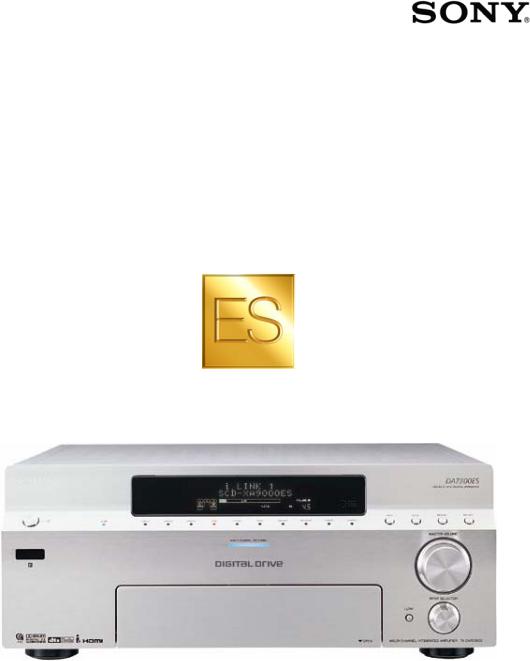
ES Series Receivers
Technical Background
Version 1.1; May 25, 2005
A new generation of A/V receivers
Digital home theater continues to advance at breakneck speed. You can listen to upgraded surround sound formats, including Dolby Digital® EX 6.1 channel sound, dts® ES discrete 6.1 and dts Neo6:cinema. You can watch High Definition video from over-the-air broadcasting, cable, satellite, HDV camcorders, HD home videocassette recorders and HD digital video recorders. You can enjoy surround sound from as many as nine speakers.
At the heart of the home theater—switching it all, decoding it all and reproducing all the sound—stands the A/V receiver. And this single component is challenged as never before. How do you coordinate and switch all those sources, preserving audio and video in their most pristine form? How do you pack all those channels of amplification in a single chassis and still deliver the quality and power that home theater requires? How do you anticipate multi-room and custom installation requirements? These questions are daunting. And the answers determine the quality and suitability of any modern A/V receiver.
The engineers of Sony ES Series don't simply answer these questions.
They help drive the technology that brings these questions into being. Thanks in part to this expertise, Sony's ES Series receivers have been praised by equipment reviewers, cherished by home theater enthusiasts and scrutinized by an entire industry. Sony's latest ES Series A/V receivers, particularly the STR-
DA7100ES, establish an important benchmark in home theater design with three crucial advantages:
•S-Master Pro digital amplifiers with 32-bit processing and a new generation of MOS FET output transistors.
•HDMI inputs, upconversion, switching and output.
•i.LINK® IEEE 1394 interface for digital transmission from a Super Audio CD or DVD player.
In this way, our latest A/V receivers carry forward the proud tradition of the Sony ES Series, the Elevated Standard in audio and video.
Digital Home Theater and Sony ES......................... |
Page 3 |
S-Master Pro amplifier with 32-bit DSP.................... |
Page 4 |
HDMI inputs and switching....................................... |
Page 16 |
i.LINK IEEE 1394 interface....................................... |
Page 23 |
Other New Features.................................................. |
Page 26 |
Performance Series Receivers………………………. |
Page 28 |
Continuing Features.................................................. |
Page 35 |
Features and Specifications...................................... |
Page 37 |
ES Receivers v1.0 |
Page 2 |
Digital home theater and the ES Series
The engineers of the Sony ES Series haven't simply witnessed the digital home theater revolution. They've been driving it forward. After all, it was Sony that launched and spearheaded so many of the entertainment formats that define digital home theater. We co-invented the Compact Disc, DVD and Super Audio CD. We're a global leader in professional High Definition production equipment, as well as a leader in HDTVs. We've launched consumer High Definition camcorders. And in Japan, we marketed the world's first Blu-ray Disc™ High Definition recorder.
This heritage, unmatched in home entertainment, has inspired Sony engineers since the very birth of the ES Series, leading us to create landmarks in home entertainment:
•The world's first CD player with digital output and the world's first outboard D/A converter (CDP-650ES and DAS-702ES, 1985).
•The world's first all-digital preamplifier (TA-E1000ESD, 1989).
•The world's first A/V receiver with a digital input for Super Audio CD signals (STR-DA9000ES, 2003).
•Digital amplification in a high-end A/V receiver (STR-DA9000ES, 2003).
•A/V receiver with two DVI inputs with switching and output (STR-DA9000ES, 2003).
Sony's latest A/V receivers are worthy successors, bringing this heritage to a new generation of home entertainment enthusiasts.
ES Receivers v1.0 |
Page 3 |
S-Master Pro amplifier with 32-bit DSP
The video signal in home theater is increasingly digital from the latest digital cinematography in Hollywood through digital transmission channels to digital television display panels. The audio in home theater is increasingly digital from the microphone mixing console through the distribution channels, to the digital inputs and digital signal processing of your A/V receiver. With digital sources, digital switching and digital preamplification, it was only a matter of time until the power amplifier also made the move from analog to digital.
Even so, some observers were surprised in 2003 when Sony introduced ES Series A/V receivers with a digital amplifier we called S-Master Pro. Fiercely independent critics evaluated the Sony STR-DA9000ES receiver using the finest source material and ancillary equipment. Their response was overwhelming. They brought out their highest superlatives, calling the sound of the DA9000ES "airy," "delicate," "pure," "relaxed," "open," "fantastic," and "a revelation."
Not content with establishing a new benchmark in A/V receiver sound quality, the engineers of Sony's ES Series continue to press ahead with an upgraded, 32-bit S-Master Pro LSI, redesigned MOS FET transistors and a fresh approach to transistor cooling.
Process |
S-Master |
"Digital Drive" |
S-Master Pro |
S-Master Pro |
||||
|
|
|
S-Master |
|
|
(2005) |
||
Generation |
First |
Second |
Third |
Fourth |
||||
Introduction |
2001 |
2002 |
2003 |
2005 |
||||
Technologies |
• |
Clean Data Cycle |
• |
Clean Data Cycle |
• |
Clean Data Cycle |
• |
32-bit S-Master |
|
• |
C-PLM |
• |
C-PLM |
• |
C-PLM |
• |
Pro DSP |
|
• |
S-TACT |
• |
S-TACT |
• |
S-TACT |
Clean Data Cycle |
|
|
|
|
• |
Pulse Height |
• |
Pulse Height |
• |
C-PLM |
|
|
|
|
Volume Control |
• |
Volume Control |
• |
S-TACT |
|
|
|
|
|
DC Phase |
• |
Pulse Height |
|
|
|
|
|
|
• |
Linearizer |
• |
Volume Control |
|
|
|
|
|
Discrete Output |
Integrated DC |
||
|
|
|
|
|
|
Transistors |
• |
Phase Linearizer |
|
|
|
|
|
|
|
Discrete MOS |
|
|
|
|
|
|
|
|
|
FET Output |
|
|
|
|
|
|
|
|
Transistors, |
|
|
|
|
|
|
|
|
redesigned |
|
|
|
|
|
|
|
|
cooling |
ES Receivers v1.0 |
Page 4 |
Why Digital Amplification?
After decades of engineering practice, the limitations and awkward characteristics of traditional amplifiers have become so familiar that most engineers don't even notice them:
•Complexity. In the context of today's home theater receivers, you have digital source material processed through a digital preamplifier—only to be converted to analog prior to amplification.
•Heat generation. Conventional power output transistors throw off much of their power as heat. And heat is always bad for electronics.
•Thermal modulation distortion. Changes in the audio signal cause immediate changes in the output transistor temperature, which in turn cause changes in transistor performance! This is thermal modulation distortion.
•Crossover distortion. Conventional transistor pairs create crossover distortion, which becomes particularly audible during quiet passages. The normal solution is amplifier bias—which means more heat!
•Open-loop distortion. Traditional amplifiers typically generate substantial "open-loop" distortion. The Negative Feedback (NFB) used to correct this can trigger other problems like Transient Intermodulation Distortion.
Commonly understood for decades, these limitations are so thoroughly ingrained in home audio design that they're considered "inevitable." Resolving these issues means accepting massive heat sinks, tolerating circuitous signal paths and chasing down transient distortions. Sony engineers sought a better way. Sony's S-Master Pro circuitry overcomes these fundamental constraints by completely replacing analog amplification with digital technology.
Digital amplifiers had been around for decades, outside the mainstream of home audio. But great strides in Large Scale Integration (LSI), 1-bit processing and faster MOS FET output transistors have opened the door to a new generation of digital amplifier technology.
S-Master Pro: principle of operation
In the context of a modern A/V receiver, traditional power amplifiers require the needless complexity of D/A conversion, Low Pass Filtering (LPF) and analog volume control prior to the input.
ES Receivers v1.0 |
Page 5 |
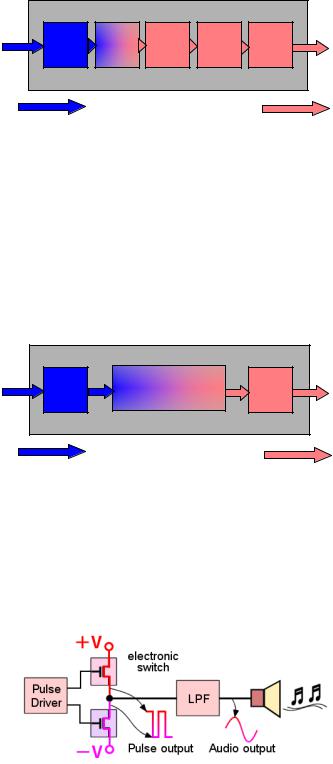
Input |
DSP |
D/A |
LPF |
Volume |
Analog |
Speaker |
|
Power |
|||||||
(Digital) |
convert |
Control |
Output |
||||
|
|
Amp |
|||||
|
|
|
|
|
|
Digital Signal |
Analog Signal |
The conventional A/V receiver is anything but simple. The signal must run through a gantlet of processes and stages.
The Sony S-Master Pro amplifier is dramatically different. There is no Digital-to-Analog (D/A) converter. Instead, the amplifier accepts all digital signals directly, whether they're multi-bit Pulse Code Modulation (PCM) or 1-bit Direct
Stream Digital™ pulses from Super Audio CD. Even analog inputs are converted to DSD. The output of the S-Master Pro amplifier goes through a single Low Pass Filter to provide the wattage that drives the speakers. In this way, the signal remains digital until the last possible instant.
Input |
DSP |
S-Master |
LPF |
Speaker |
|
(Digital) |
Power Amplifier |
Output |
|||
|
|
Digital Signal |
Analog Signal |
The Sony S-Master Pro amplifier dramatically simplifies receiver design.
And in high fidelity, simpler is better.
The S-Master power amplifier generates a 1-bit pulse stream to switch pairs of MOS FET power output transistors on and off. The resulting output has more than enough wattage to drive a loudspeaker.
The output transistors act like an on/off switch for the power supply voltage. The Low Pass Filter (LPF) converts the amplified pulses to a smooth, continuous analog waveform.
The S-Master 1-bit pulse stream has much in common with the Direct
Stream Digital signal that Sony developed for Super Audio CD. If you look
ES Receivers v1.0 |
Page 6 |

carefully at the pulses, you'll see that where the audio waveform is positive, the pulses are mostly 1. Where the audio waveform is negative, the pulses are mostly 0. In this way, a 1-bit pulse stream can represent the audio signal. As with a DSD signal, a Low Pass Filter (LPF) is all you need to recover the original audio signal.
In the diagram above, (A) represents the output power pulse stream. This combines two components, the original audio signal (B) and a noise component (C). The audio signal (B) looks smooth and continuous because the frequencies are low. The noise component (C) looks abrupt and spiky because the frequencies are high. The Low Pass Filter (LPF) effectively separates out the audio signal, for extremely accurate music reproduction.
Inside the S-Master Pro process
While Sony's S-Master Pro amplifier is simple in principle, the fidelity of the output signal depends on getting each pulse exactly right. That is, the leading and trailing edges of each pulse must have the right timing—and the height of each pulse must be carefully controlled. This is comparable to the requirements for Super Audio CD playback. So to accomplish these goals, Sony used technologies developed for our legendary SCD-1 Super Audio CD player.
Sony's CXD9773Q S-Master Pro LSI incorporates several stages of crucial signal processing.
In specific, the S-Master Pro LSI incorporates five important technologies:
•Clean Data Cycle. "Jitter" or time-base errors can degrade the accuracy of digital signals. That's why the first stage of the S-Master Pro process is
Sony's Clean Data Cycle. This regenerates the digital signal with time-axis accuracy equivalent to the original A/D converter at the recording studio. In
ES Receivers v1.0 |
Page 7 |
this way, jitter is completely eliminated—and the integrity of the original musical signal is restored.
•DC Phase Linearizer (DCPL). Interaction between traditional amplifiers and real-world loudspeakers cause significant departure from phase linearity at frequencies below 30 or 50 Hz. These shifts have a subtle effect, creating warmer and more accessible bass. Sony's DC Phase Linearizer gives you several control positions, including Off, enabling you to adjust low-frequency phase shift and restore this effect.
•Complementary Pulse Length Modulation (C-PLM). Previous digital amplifiers have used a 1-bit technology called Pulse Width Modulation or PWM. Those digital amplifiers varied the width of pulses. Unfortunately,
PWM tends to expose the signal to second-order harmonic distortion. C-PLM effectively controls the distortion, maintaining the integrity of the musical signal.
•Synchronous Time Accuracy Controller (S-TACT). Because C-PLM conversion expresses the music in a different digital form, the signal requires another round of correction for time-base errors. Synchronous Time
Accuracy Controller (S-TACT), originally developed for Sony's SCD-1 Super Audio CD player, effectively clears pulse generator jitter by referencing the output directly to the master clock. This establishes extremely accurate pulse timing for amazingly low distortion.
•Pulse Height Volume Control. Most digital volume controls work by Digital Signal Processing, an approach that sacrifices detail in the least significant bit. Sony's Pulse Height Volume control adjusts the 1-bit C-PLM stream by adjusting the regulator that supplies voltage to the power pulse generator. Because this method does not modify or reshape the original digital samples, there's no loss of information, no loss of detail. Sound quality is maintained from very low volume settings all the way to maximum.
S-Master Pro Benefits
Sony's S-Master Pro design delivers a host of benefits.
•Simplicity. Digital signals remain in the digital domain until the last possible moment. The purity and clarity of digital source material is maintained.
•Low heat generation. With S-Master Pro, the output MOS FET transistors simply switch between fully On and fully Off states. The transistors operate at nearly maximum thermal efficiency. This has a profound impact on the physical design of the power amplifier.
oThe amps can be far more compact, because the heat sinks take up far less space. This is a major consideration when you have seven amplifiers, each putting out 170 watts per channel (all channels driven, 8 ohms, 20 to 20,000 Hz, at 0.15% THD).
ES Receivers v1.0 |
Page 8 |
oInstead of isolating the power amplifier because it runs too hot, the amps can be located anywhere in the chassis that makes the most sense.
oWith this new freedom in locating the amplifier, the circuit paths inside the chassis can be rationalized. In Sony's words, they can be made "short, simple and straight."
•Minimum thermal modulation distortion. In traditional amplifiers, the output transistors must reproduce the waveform directly. This means the heat inside the transistors changes rapidly—getting hotter during the middle ranges of the audio waveform when the transistor is inefficient. Unfortunately, the changing heat can degrade the electrical performance of the transistor, generating thermal modulation distortion. Because the S-Master Pro transistors simply switch from full-on to full-off. There's almost no power wasted as heat. So thermal modulation is held to a minimum.
•No crossover distortion. Conventional power amplifiers use separate transistors to reproduce the upper and lower halves of the waveform. This tends to generate the glitches of crossover distortion, which is particularly audible when the music is soft. Because the S-Master Pro amplifier uses pulse density, the output transistors do not generate the waveform. Any switching glitches get removed from the music by the low pass filter. In this way, the system is immune to crossover distortion, even when the music or movie sound track is particularly soft.
•Superb open-loop performance. Traditional amplifiers typically generate substantial distortion in "open-loop" mode. That's why analog amps use Negative Feedback (NFB). Unfortunately, NFB exposes the signal to Transient Intermodulation Distortion and other dynamic problems. In contrast, the Sony S-Master Pro amplifier achieves excellent fidelity without any negative feedback at all! Distortion remains low without any sacrifice in transient and dynamic characteristics. Music comes alive.
Independent reviewers have heaped praise on Sony's S-Master Pro amplifier. But you don't need a magazine review (or a white paper) to appreciate the results. Use good speakers, a suitable disc player and a Super Audio Compact Disc that you know well. Then sit back and listen carefully. Dynamics are powerful but not forced. Bass is vigorous but not boomy. Music is rendered in very high resolution, against a background of silky silence.
The 32-bit Upgrade
Where the acclaimed STR-DA9000ES took advantage of 24-bit S-Master
Pro processing, Sony's latest design boasts the superior precision of Sony's 32bit processing. Sony proudly presents a masterpiece of integrated circuitry,
Sony's CXD9773Q Large Scale Integrated circuit (LSI).
ES Receivers v1.0 |
Page 9 |
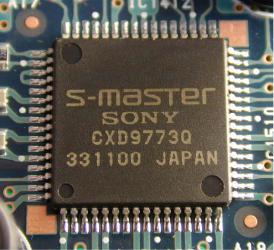
As a primary manufacturer of Large Scale Integrated circuits (LSIs), Sony has the freedom to pursue innovative thinking like S-Master Pro and then express this thinking in silicon. The result is Sony's own CXD9773Q.
•Superior dynamic range. The previous S-Master Pro LSI achieved 24-bit processing at 1024 fs. This translates to an impressive 34 bits of resolution at the 48 kHz sampling rate (fs). The new CXD9773Q goes much further, with
32-bit processing at 1024 fs. Internal dynamic range at the 48 kHz sampling rate is improved from 180 dB to 228 dB. When Super Audio CD signals are sampled at 8 fs, the internal dynamic range improves from 162 dB to 210 dB out to nearly 100 kHz. Clearly, the new 32-bit processor has more than enough dynamic range for the most demanding digital audio sources.
•Higher accuracy for the Clean Data Cycle. Because one-bit digital signals depend on the accuracy of the time domain, Sony suppresses jitter with
Clean Data Cycle. Our 24-bit processor achieved a theoretical accuracy of
40 femtoseconds. One femtosecond is 1/1,000,000,000,000,000 second (in scientific notation, 10-15 second). For comparison, it takes a billion femtoseconds to equal one nanosecond. Stated another way, there are as many femtoseconds in one full second as there are seconds in 30 million years!
So it's fair to say that accuracy of 40 femtoseconds is fairly precise. However our 32-bit processor goes well beyond this, to an accuracy of 0.08 femtoseconds (or 80 attoseconds, if you prefer). This is about the same time it takes an electron to fluctuate within a single lattice of a metal crystal. So we can say that the 32-bit Clean Data Cycle reduces jitter to the theoretical minimum. (Note: This measure, 80 attoseconds is roughly four orders of magnitude more precise than the jitter induced by chassis vibration. From a practical standpoint, suppressing chassis vibration has a great impact on the final sound quality.)
ES Receivers v1.0 |
Page 10 |
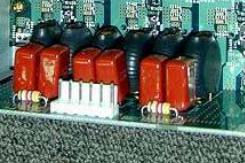
•Built in DC Phase Linearizer. Where Sony's 24-bit LSI required a second chip to contain the DC Phase Linearizer, this circuitry is built right into Sony's 32-bit design. The process is performed by Infinite Impulse Response (IIR) calculation, which processes more data in less time.
In this way, Sony has taken the critically-acclaimed S-Master Pro amplifier to a higher level of precision and performance. Those fortunate enough to own of the STR-DA7100ES will experience superb clarity of expression, relaxed listening hour after hour, and the effortless dynamics to handle everything from a the Dies Irae of Verdi's Requiem to the meteor impacts of the latest action movie.
Toroidal Low Pass Filter
The Low Pass Filter is a crucial stage in any digital amplifier. The filter must have a turnover frequency high enough for high-resolution audio, yet have a cutoff characteristic steep enough to suppress high-frequency noise elements. In this way, the filter has a major influence on sound quality. That's why the engineers of Sony ES selected the filter parts carefully and methodically. Instead of choosing less expensive cylinder-type coils, the ES engineers chose exotic toroidal coils, optimized for sound. Customers will never see these toroidal coils, but they will hear the benefits in clean, open, non-fatiguing music reproduction.
Shown here wrapped in black, the toroidal coils of Sony's Low Pass Filters are more expensive. But their contribution to sound is more than worth the price.
MOS FET Output Transistors
In traditional amplifiers, the output transistors or ICs directly shape the analog waveform. For this reason, traditional amplifiers are extremely sensitive to the selection, configuration, bias current and heat sinking of their output devices. By their design, digital amplifiers are inherently less sensitive to these factors. That's why some previous digital amplifiers have used relatively inexpensive integrated circuit op-amps at the output. But Sony ES engineers were after the best possible sound. So they selected deluxe Metal Oxide
ES Receivers v1.0 |
Page 11 |
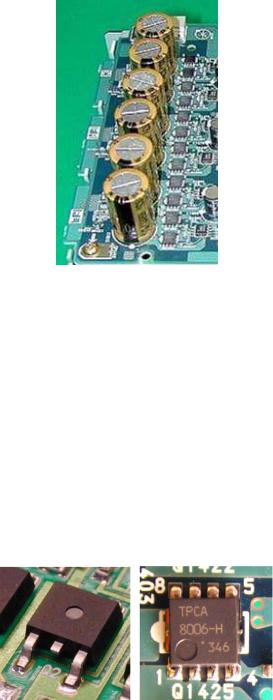
Semiconductor Field Effect Transistors (MOS FETs), four per channel, for the
STR-DA7100ES. The result is another measure of signal integrity.
A detail of the power amplifier circuit board of the STR-DA7100ES. The twelve black chips are the MOS FET output transistors for three channels (4 MOS FETs per channel).
Sony output transistors are remarkable for their internal wiring and bonding, their unique packaging and the way they're configured on the power amplifier circuit board. Consider the packaging.
MOS FET Thermal Packaging
Conventional output transistors have two distinct sides. The bottom is designed to radiate heat, and is usually attached to a metal heat sink. The top is fashioned from molded plastic, from which heat cannot escape. No matter how much cooling may be available at the top, the plastic package is too thick to conduct heat away from the transistor.
On the left, the MOS FET output transistor used in Sony's STR-
DA9000ES was 2 to 3 mm thick. At right, the MOS FETs used in the
DA7100ES is 1 mm thick or less, for far better dissipation of heat.
ES Receivers v1.0 |
Page 12 |
